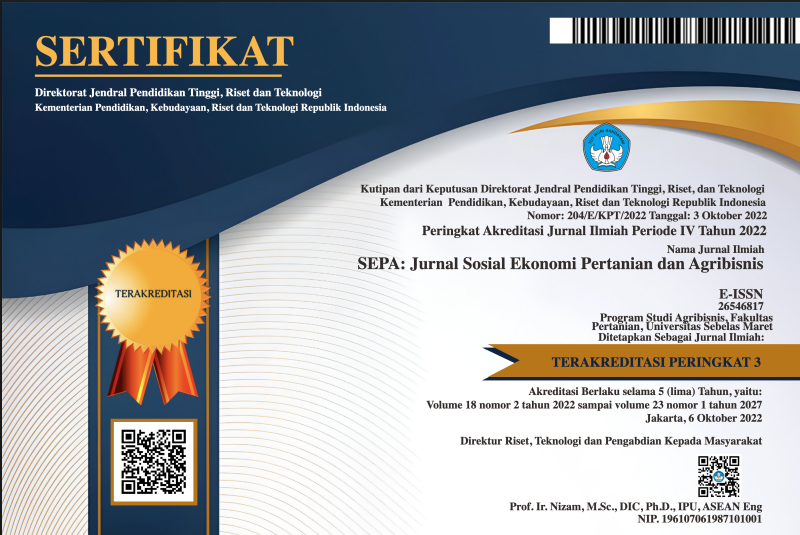AGROINDUSTRI PENGOLAHAN TANAMAN PANGAN DI KECAMATAN PONJONG KABUPATEN GUNUNG KIDUL
Abstract
This research was purposed to know: 1) the properness of agroindustries utilize local crops as raw materials, 2) The added value and profit of agroindustry utilize the local crops as raw materials, 3) The poverty and prosperity level of farmer’s households in the research area. The kind of crops that researched are paddy, corn, soya beans, ground nuts, and cassava. This research located in two villages, Bedoyo village and Sumbergiri village, Kecamatan Ponjong, Kabupaten Gunung Kidul, Regency of Yogyakarta. The used basic method was analytic descriptive, with purposive approach to choose samples of the 90 farmer households which have crops fields and agroindustries. From the data analysis we can inform that: 1) Agroindustry using cassava, corn, soya beans, and ground nuts as raw materials were profitable and could absorb a lot of labors around the environtment with range of /C ratio betw een 1,13 – 186,17%, 2) Agroindustry using paddy as raw material was not profitable and ineffecient because its taking too much labor, 3) Average incomes of farmers about Rp 10.502.202/year and they are not in poverty, 4) Food agroindustries contribute to farmer’s income about Rp 14.021.262/year. It draws a conclussion food agroindustries have lots of adventages 1) help increasing farmer’s income 2) absorb labor from the environtment, 3) with grow the industries scale can increasing farmer’s skills and prosperity.
Penelitian ini bertujuanuntuk mengetahui: 1) kelayakan, 2) nilai tambahdan
keuntungan, 3) kemiskinandan kesejahteraanrumah tanggapetaniagroindustripengolah
tanamanlokalsebagai bahan baku.Jenistanamanyangditelitiadalahpadi, jagung, kedelai,
kacang tanah, danketela pohon. Penelitian dilakukan diDesaBedoyodanSumbergiri,
KecamatanPonjong, Gunungkidul. Menggunakan metodedasaranalitikdeskriptif,
dengan purposivesampling 90rumah tangga petaniyangmengusahakan tanaman
pangandan agroindustrinya. Hasil analisis menunjukkanbahwa: 1) agroindustri
berbahan baku ketela pohon, jagung, kedelai, dan kacang tanah menguntungkan dan
mampu menyerap banyak tenaga kerja (/Cantara1,13-186,17%), 2) agroindustri
berbahan baku padi tidak menguntungkan dan tidak efisien karena mengambil terlalu
banyak tenaga kerja, 3) pendapatan rata-rata rumah tangga tani Rp10.502.202/tahun
dan tergolong tidak miskin, 4) agro industri pangan berkontribusi terhadap pendapatan
rumah tangga rata-rata sebesar Rp14.021.262/tahun. Kesimpulannya, agroindustri
pangan memiliki banyak keuntungan, yaitu: 1) meningkatkan pendapatan 2) menyerap
tenaga kerja, 3) meningkatkan kesejahteraan petani.
Keywords
Full Text:
PDFReferences
Azra, M. 2005. Strategi Pemberdayaan Industri Kecil Berbasis Agroindustri di Pedesaan. . Diakses 2 Maret 2013.
Hasanah, U. 2009. Analisis Nilai Tambah Agroindustri Sale Pisang di Kabupaten Kebumen. Tesis. Sekolah Pascasarjana. Universitas Gadjah Mada. Yogyakarta.
Nawawi, H.H. dan Mimi Martini. 1994. Penelitian Terapan. Gadjah Mada University Press. Yogyakarta.
Putri, D.D. 2003. Analisis Nilai Tambah Pengolahan Garut di Desa Argodadi Kecamatan Sedayu Kabupaten Bantul. Skripsi. Fakultas Pertanian. Universitas Gadjah Mada. Yogyakarta.
Suratiyah, K. 2011. Ilmu Usahatani. Penebar Swadaya. Bogor.
Suratiyah, K. dan Pinjung Nawang Sari. 2012. Analisis Usahatani Padi dengan Metode System of Rice Intensification (SRI) di Kabupaten Gunungkidul. Laporan Penelitian. Hibah Penelitian Magister Manajemen Agribisnis. Universitas Gadjah Mada. Yogyakarta.
DOI: https://doi.org/10.20961/sepa.v11i1.14154
Refbacks
- There are currently no refbacks.



.png)







.png)
3.png)





